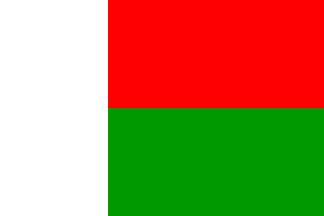

Last modified: 2004-12-29 by jarig bakker
Keywords: madagascar | malagasy |
Links: FOTW homepage |
search |
disclaimer and copyright |
write us |
mirrors

![]()
![]() 2:3~by Antonio Martins 24 April 1999
2:3~by Antonio Martins 24 April 1999
There are two references, which do not agree with each other, about this difficult topic, only marginally treated in FOTW-ws.
1. Smith (1975):
"Many Malagasy are descended from settlers who originally came from
South-East Asia, suggesting that its red and white flags (see Indonesia)
influenced similar red and white flags flown by the Hova empire in 19th
century Madagascar. Those Hova flags were the basis for the tricolor adopted
shortly after Madagascar became the Malagasy Republic. Green was added
for the coastal people.
Historically, red is associated with the Volamena and the white with
the Volafotsi, princely families founded by King Andriandahifotsi (1610-1685).
His personal emblem was a red bull and the name of the kingdom was Menabe,
"Great Red".
2. DK Ultimate Pocket (1997)
"The red and white are said to symbolize the earlier Merina Kingdom,
whose flags were all red and white, with the addition of the green for
the Hova, the former peasant class."
Both sources agree on the red and the white, but there is discrepancy
about the origin of the green. Encyclopaedia Universalis (CD-ROM edition,
1998) solves it, the DK Ultimate Pocket version being the correct one.
The history of Madagascar is very complex and I just extract details significant
for the green colour case.
Smith was certainly fooled by sources dating from the French colonial
period (1885-1960). At that time, Merina and Hova were used as synonyms.
In fact, the Merina Kingdom (founded in 1787 by unifying several small
princely states of the island), had a very strict social hierarchy, based
on three main classes: the "andriana" (nobility), the "hova" (free commoners,
mostly peasants), and the "andevo" (black slaves). From time to time, the
Prime Minister of the Kingdom had been of Hova origin, and
the Hova class was the source of quasi-permanent anti-French agitation.
(I suppose the French colonial rhetorics used the shortcut Hova = Merina
to reduce the Malagasy people to a bunch of illiterate peasants). There
had never been any Hova Kingdom or "Hova Empire" as reported by Smith.
I do not know how the "coastal peoples" he mentioned were ranked in the
Merina system (they usually belong to different ethnies and still tend
to live in autarcy, and I imagine they were of very low rank, if any),
but the green strip cannot be attributed to them (or it was a later "reattribution"
for political reasons). The Menabe kingdom mentioned by Smith was a powerful
state which could unify for several years the small kingdoms in permanent
state of war with each other.
Ivan Sache, 28 Jun 1999
Madagascar flag colors according to Album 2000:
"Official" Pantone and "approx." CMYK
R: Warm Red